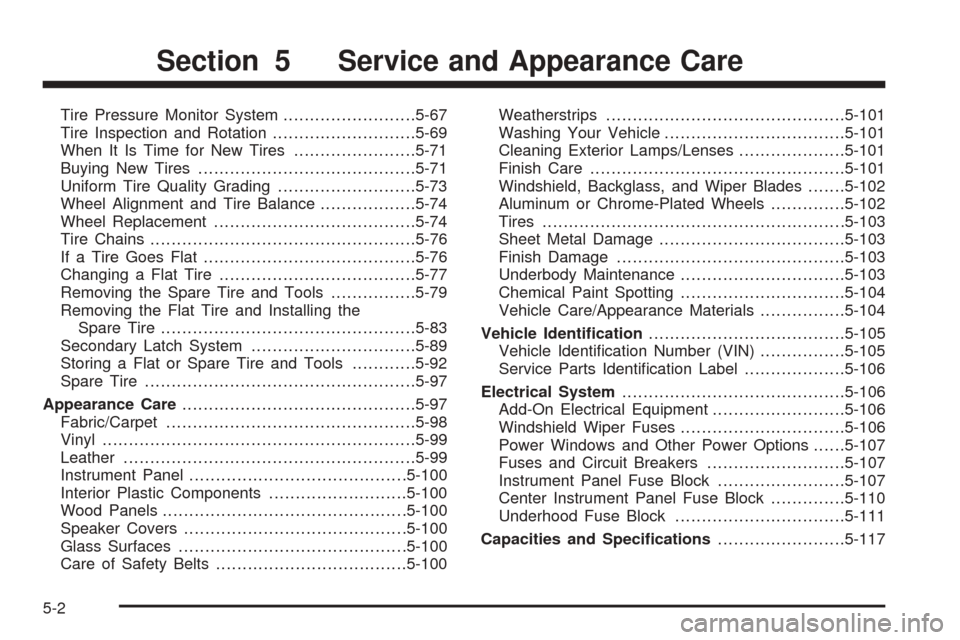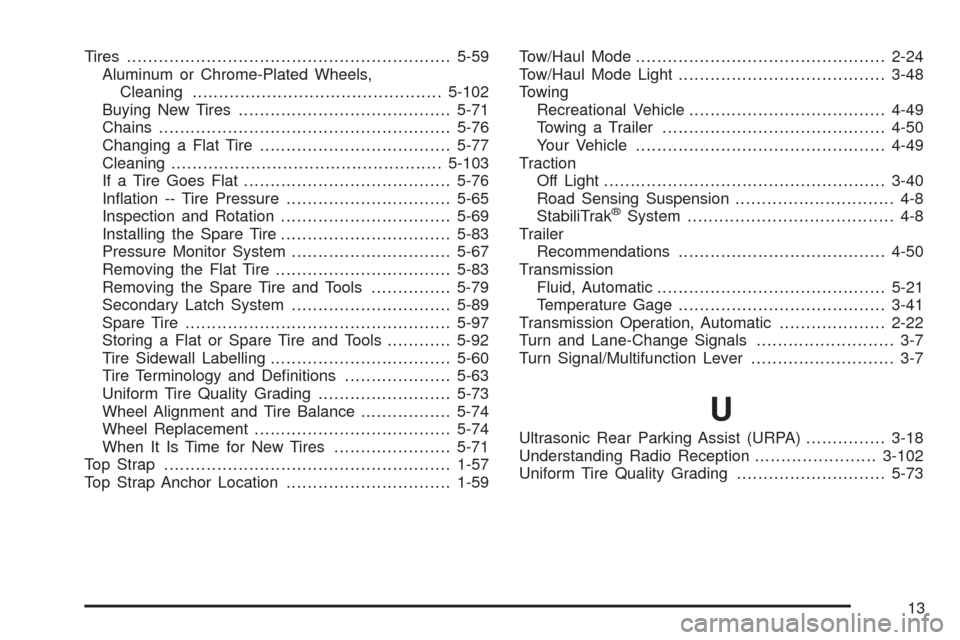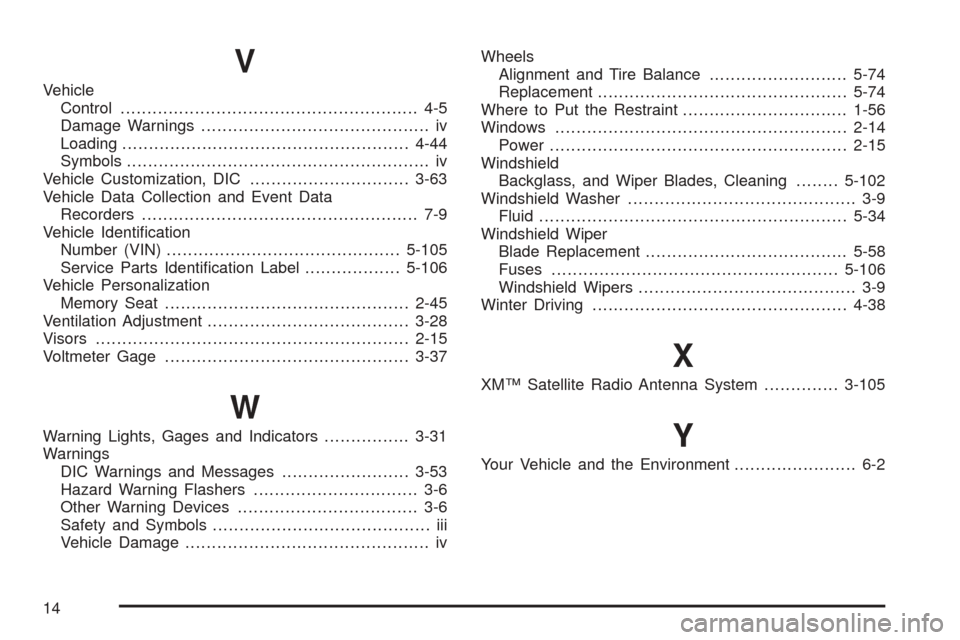wheel alignment CADILLAC ESCALADE ESV 2005 2.G Owners Manual
[x] Cancel search | Manufacturer: CADILLAC, Model Year: 2005, Model line: ESCALADE ESV, Model: CADILLAC ESCALADE ESV 2005 2.GPages: 470, PDF Size: 2.86 MB
Page 308 of 470

Tire Pressure Monitor System.........................5-67
Tire Inspection and Rotation...........................5-69
When It Is Time for New Tires.......................5-71
Buying New Tires.........................................5-71
Uniform Tire Quality Grading..........................5-73
Wheel Alignment and Tire Balance..................5-74
Wheel Replacement......................................5-74
Tire Chains..................................................5-76
If a Tire Goes Flat........................................5-76
Changing a Flat Tire.....................................5-77
Removing the Spare Tire and Tools................5-79
Removing the Flat Tire and Installing the
Spare Tire................................................5-83
Secondary Latch System...............................5-89
Storing a Flat or Spare Tire and Tools............5-92
Spare Tire...................................................5-97
Appearance Care............................................5-97
Fabric/Carpet...............................................5-98
Vinyl...........................................................5-99
Leather.......................................................5-99
Instrument Panel.........................................5-100
Interior Plastic Components..........................5-100
Wood Panels..............................................5-100
Speaker Covers..........................................5-100
Glass Surfaces...........................................5-100
Care of Safety Belts....................................5-100Weatherstrips.............................................5-101
Washing Your Vehicle..................................5-101
Cleaning Exterior Lamps/Lenses....................5-101
Finish Care................................................5-101
Windshield, Backglass, and Wiper Blades.......5-102
Aluminum or Chrome-Plated Wheels..............5-102
Tires.........................................................5-103
Sheet Metal Damage...................................5-103
Finish Damage...........................................5-103
Underbody Maintenance...............................5-103
Chemical Paint Spotting...............................5-104
Vehicle Care/Appearance Materials................5-104
Vehicle Identi�cation.....................................5-105
Vehicle Identi�cation Number (VIN)................5-105
Service Parts Identi�cation Label...................5-106
Electrical System..........................................5-106
Add-On Electrical Equipment.........................5-106
Windshield Wiper Fuses...............................5-106
Power Windows and Other Power Options......5-107
Fuses and Circuit Breakers..........................5-107
Instrument Panel Fuse Block........................5-107
Center Instrument Panel Fuse Block..............5-110
Underhood Fuse Block................................5-111
Capacities and Speci�cations........................5-117
Section 5 Service and Appearance Care
5-2
Page 375 of 470

10. Set all four tires to the recommended air pressure
level as indicated on the Tire and Loading
Information label.
11. Put the valve caps back on the valve stems
The spare tire does not have a TPM sensor. If you
replace one of the road tires with the spare, the CHECK
TIRE PRESSURE message will be displayed on the
DIC screen. This message should go off once you
re-install the road tire containing the TPM sensor. The
SERVICE TIRE MONITOR message is displayed
when the TPM system is malfunctioning. One or more
missing or inoperable TPM sensors will cause the
service tire monitor message to be displayed. See your
dealer for service.
Federal Communications Commission and
Industry and Science Canada
The TPM system operates on a radio frequency subject
to Federal Communications Commission (FCC) Rules
and with Industry and Science Canada.This device complies with Part 15 of the FCC Rules and
with RSS-210 of Industry and Science Canada.
Operation is subject to the following two conditions: (1)
This device may not cause harmful interference, and
(2) this device must accept any interference received
including interference that may cause undesired
operation of the device.
Changes or modi�cations to this system by other than
an authorized service facility could void authorization to
use this equipment.
Tire Inspection and Rotation
Tires should be rotated every 5,000 to 8,000 miles
(8 000 to 13 000 km).
Any time you notice unusual wear, rotate your tires as
soon as possible and check wheel alignment. Also
check for damaged tires or wheels. SeeWhen It Is Time
for New Tires on page 5-71andWheel Replacement
on page 5-74for more information.
5-69
Page 380 of 470

Temperature – A, B, C
The temperature grades are A (the highest), B, and C,
representing the tire’s resistance to the generation
of heat and its ability to dissipate heat when tested
under controlled conditions on a speci�ed indoor
laboratory test wheel. Sustained high temperature can
cause the material of the tire to degenerate and
reduce tire life, and excessive temperature can lead to
sudden tire failure. The grade C corresponds to a
level of performance which all passenger car tires must
meet under the Federal Motor Vehicle Safety Standard
No. 109. Grades B and A represent higher levels of
performance on the laboratory test wheel than the
minimum required by law.
Warning: The temperature grade for this tire is
established for a tire that is properly in�ated and not
overloaded. Excessive speed, underin�ation, or
excessive loading, either separately or in combination,
can cause heat buildup and possible tire failure.
Wheel Alignment and Tire Balance
The wheels on your vehicle were aligned and balanced
carefully at the factory to give you the longest tire life
and best overall performance.If you notice unusual tire wear or your vehicle pulling
one way or the other, the alignment may need to
be reset. If you notice your vehicle vibrating when driving
on a smooth road, your wheels may need to be
rebalanced.
Wheel Replacement
Replace any wheel that is bent, cracked, or badly rusted
or corroded. If wheel nuts keep coming loose, the
wheel, wheel bolts and wheel nuts should be replaced.
If the wheel leaks air, replace it (except some
aluminum wheels, which can sometimes be repaired).
See your dealer if any of these conditions exist.
Your dealer will know the kind of wheel you need.
Each new wheel should have the same load-carrying
capacity, diameter, width, offset and be mounted
the same way as the one it replaces.
If you need to replace any of your wheels, wheel bolts
or wheel nuts, replace them only with new GM
original equipment parts. This way, you will be sure to
have the right wheel, wheel bolts and wheel nuts
for your vehicle.
5-74
Page 469 of 470

Tires.............................................................5-59
Aluminum or Chrome-Plated Wheels,
Cleaning...............................................5-102
Buying New Tires........................................5-71
Chains.......................................................5-76
Changing a Flat Tire....................................5-77
Cleaning...................................................5-103
If a Tire Goes Flat.......................................5-76
In�ation -- Tire Pressure...............................5-65
Inspection and Rotation................................5-69
Installing the Spare Tire................................5-83
Pressure Monitor System..............................5-67
Removing the Flat Tire.................................5-83
Removing the Spare Tire and Tools...............5-79
Secondary Latch System..............................5-89
Spare Tire..................................................5-97
Storing a Flat or Spare Tire and Tools............5-92
Tire Sidewall Labelling..................................5-60
Tire Terminology and De�nitions....................5-63
Uniform Tire Quality Grading.........................5-73
Wheel Alignment and Tire Balance.................5-74
Wheel Replacement.....................................5-74
When It Is Time for New Tires......................5-71
Top Strap......................................................1-57
Top Strap Anchor Location...............................1-59Tow/Haul Mode...............................................2-24
Tow/Haul Mode Light.......................................3-48
Towing
Recreational Vehicle.....................................4-49
Towing a Trailer..........................................4-50
Your Vehicle...............................................4-49
Traction
Off Light.....................................................3-40
Road Sensing Suspension.............................. 4-8
StabiliTrak
®System....................................... 4-8
Trailer
Recommendations.......................................4-50
Transmission
Fluid, Automatic...........................................5-21
Temperature Gage.......................................3-41
Transmission Operation, Automatic....................2-22
Turn and Lane-Change Signals.......................... 3-7
Turn Signal/Multifunction Lever........................... 3-7
U
Ultrasonic Rear Parking Assist (URPA)...............3-18
Understanding Radio Reception.......................3-102
Uniform Tire Quality Grading............................5-73
13
Page 470 of 470

V
Vehicle
Control........................................................ 4-5
Damage Warnings........................................... iv
Loading......................................................4-44
Symbols......................................................... iv
Vehicle Customization, DIC..............................3-63
Vehicle Data Collection and Event Data
Recorders.................................................... 7-9
Vehicle Identi�cation
Number (VIN)............................................5-105
Service Parts Identi�cation Label..................5-106
Vehicle Personalization
Memory Seat..............................................2-45
Ventilation Adjustment......................................3-28
Visors...........................................................2-15
Voltmeter Gage..............................................3-37
W
Warning Lights, Gages and Indicators................3-31
Warnings
DIC Warnings and Messages........................3-53
Hazard Warning Flashers............................... 3-6
Other Warning Devices.................................. 3-6
Safety and Symbols......................................... iii
Vehicle Damage.............................................. ivWheels
Alignment and Tire Balance..........................5-74
Replacement...............................................5-74
Where to Put the Restraint...............................1-56
Windows.......................................................2-14
Power........................................................2-15
Windshield
Backglass, and Wiper Blades, Cleaning........5-102
Windshield Washer........................................... 3-9
Fluid..........................................................5-34
Windshield Wiper
Blade Replacement......................................5-58
Fuses......................................................5-106
Windshield Wipers......................................... 3-9
Winter Driving................................................4-38
X
XM™ Satellite Radio Antenna System..............3-105
Y
Your Vehicle and the Environment....................... 6-2
14